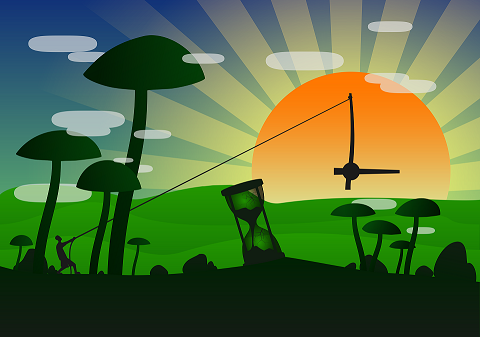
Fall is here, which means it is once again time to turn back time and adjust – that’s right folks, fall back an hour on Sunday November 1st and enjoy that extra hour of sleep!
Keep in mind, moving the clock forward and backward one hour twice a year doesn’t just affect your daily lives and schedules, it can also throw the internal schedule within your body as well.
According to an article by the Iowa clinic sleep center, that extra hour that we gain can affect our bodies for over a week. We all know how nice the falling back feels and that it is QUITE less harsh on us than springing forward. So the real adjustment truly comes in March.
But falling back can cause our internal clocks to be thrown off – affecting our sleep patterns and our eating habits. These problems can lead to both lower energy and loss of productivity. These issues are caused by the bi-annual disruption of your body’s circadian rhythm, which regulates many aspects of life — like the times in the day when you feel drowsy or alert. The abrupt time change (it literally happens overnight) changes the natural patterns of light and dark that your brain has gotten used to.
Adjusting to the time change is different for everyone. Some people adjust in a few days; for others, it takes more time.
So what can we do? Dr Gregory Hicklin, a board-certified sleep medicine physician and medical director of the West lake Sleep Center offers the following three tips to help you avoid the negative effects of adjusting to the fall change:
- Set a consistent sleep schedule. In the days leading up to the fall time change, adjust your sleep schedule. Start going to bed and waking up 10 to 15 minutes earlier each day. This eases your body into the new schedule slowly rather than forcing a harsh change on Sunday.
- Create a buffer around bedtime. Insomnia is often associated with daylight saving time’s end. Turn off electronics, don’t drink caffeine and don’t exercise close to bedtime. These external factors can make insomnia even worse.
- Boost your energy naturally. “Twenty to 30 minutes of brisk walking at mid-day may help as you find yourself hitting a wall in the morning or in the middle of your workday. Eat meals at the new time according to the clock, and don’t forget to drink your daily dose of water,” says Dr. Hicklin.
To read this article in its entirety, please visit Get Ready To Fall Back.

- Check and replace the batteries in your smoke and carbon monoxide (CO) alarms. Ensure they are working properly and replace the batteries. As the cold sets in and many start up their gas-fired furnaces, fireplaces, portable unit heaters and the like for the first time, carbon monoxide poisoning risks increase dramatically during this time of year. Replace any smoke alarm unit that is older than 10 years. Replace any CO alarm unit that is older than 5 years.
- Prepare a winter emergency kit for your automobile. Such kits can be a lifesaver if you are stuck out in bad weather while driving. They should include items such as: warm clothes, blanket, flashlight, batteries, water, non-perishable snacks, shovel, flares, reflective hazard triangle, jumper cables, cat litter or sand for traction, ski hat and gloves.
- Check to see if your fire extinguishers need recharging. Check the small gauge at the top of the extinguisher. If the needle in that gauge is in the green, chances are, the extinguisher is okay. If it is in the red, you need to have the extinguisher recharged.
For more information on Workplace Safety and Training Solutions, check out our
Safety and OSHA Training section!
Do you have a training need or a question for one of our Safety Consultants?
We are here for you – Contact Us.
Check out our Upcoming Networking Events!
Read what our consultants have to say – The Consultant’s Corner.
Safety Facts and Snacks is currently under construction. Please stay tuned for more information.
10/29/2020
Related Topics: Accident Prevention, Behavior Based Safety, Did you know, Safety Articles, Safety Awareness, Safety Tips, Winter Safety